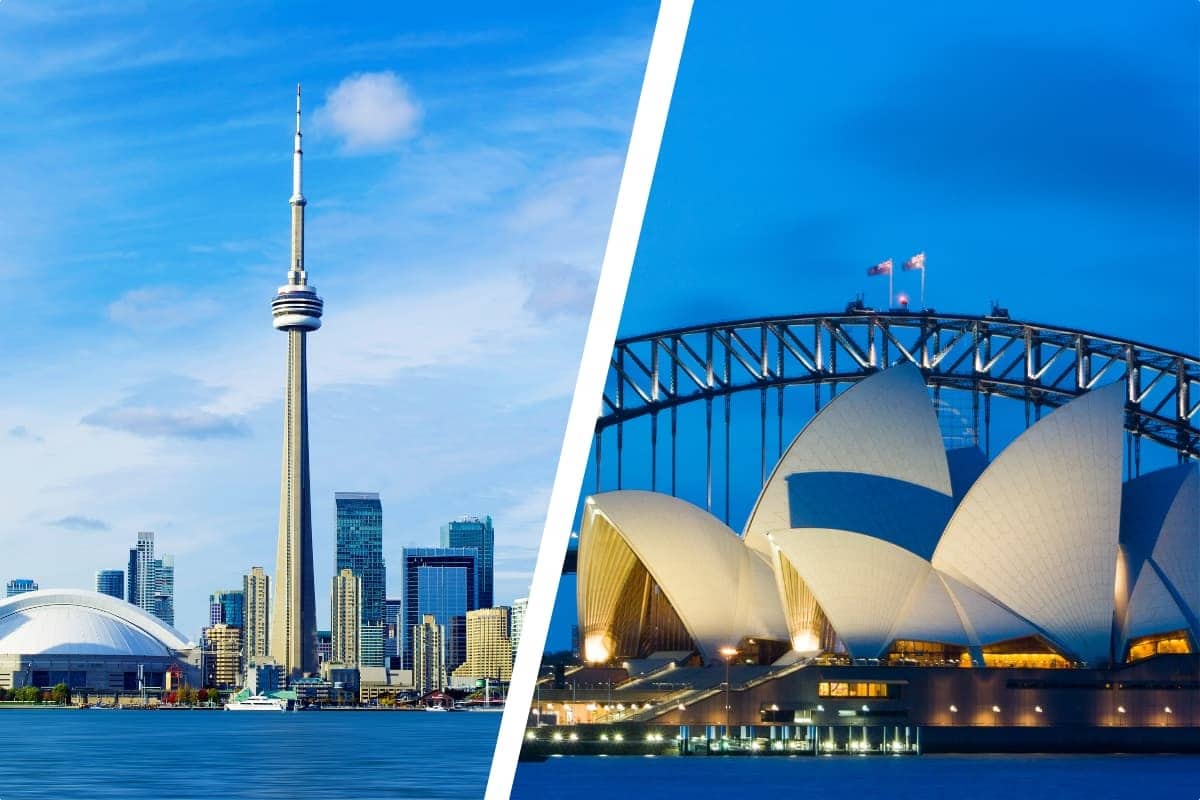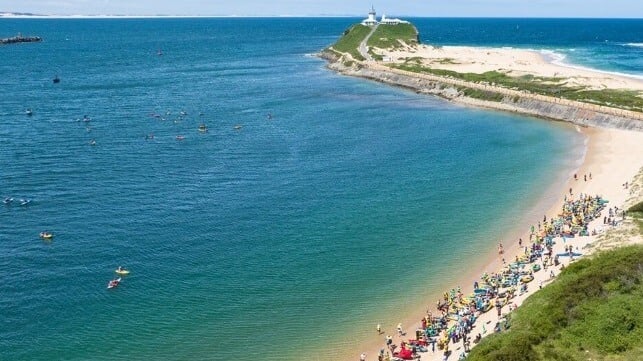Canada vs. Australia: Which country is the best choice for international students seeking immigration?

- by Admin
- November 21, 2024

If you’re looking to study overseas with the intention of immigrating after your studies, you might be considering Canada and Australia as potential destinations.
Over the course of 2024, both Canada and Australia have announced sweeping changes to their immigration systems.
Discover your options to study in Canada
Even after these changes, Canada and Australia have a lot to offer those looking for quality education, diverse and welcoming communities, and post-graduation pathways to permanent residency.
Here are the most significant differences the CIC news team has identified:
| Canada | Australia | |
| PR pathways | You can gain permanent status in Canada through a wide range of occupations, although occupations eligible for category-based draws have an advantage. | Getting permanent residence through the Skilled Independent Visa (subclass 189) is highly dependent on your occupation being under its Skilled Occupation List (SOL). |
| National work experience-based PR pathway(s) | Canadian Experience Class (CEC), a program under Express Entry for skilled workers with Canadian Experience. | No equivalent program. |
| Work hours on a study permit | Students can work unlimited hours on campus. | Limit on work hours applies equally to on-campus and off-campus work. |
| Study program restrictions for post-graduation work eligibility | For college graduates and other vocational program graduates, post-graduate work eligibility is restricted to graduates of programs aligned with in-demand occupations. | No program restrictions. |
In addition to the major differences above, we’ve also summarized detailed information on a variety of other factors, many of which are similar, but some of which have significant differences:
| Canada | Australia | |
| Number of Universities Named in QS World University Rankings 2025 Top 100 Ranking | 4 | 9 |
| Tuition cost (approximate) | 29,000 CAD to 81,000 CAD | 26,500 AUD to 113,000 AUD (24,509 CAD to 104,511 CAD) |
| Study permit cost | 150 CAD | 1,600 AUD (1,465 CAD) |
| Study permit processing time | Varies, approximately 3 months | Approximately 61 days (at time of publishing) |
| Hours international students can work while studying | 24h/week off campus during classes
Unlimited on campus during classes Unlimited during breaks |
48h every 2 weeks during classes
Unlimited during breaks No distinction between on-campus and off-campus |
| Maximum length of post-graduate work status | PGWP: up to three years | Temporary Graduate Visa – 2-3 years. |
| Popular PR Pathways for international students | Canadian Experience Class
Provincial Nominee Program (PNP) |
Skilled Independent Visa
Skilled Work Regional Visa |
| Eligible occupations for permanent status (for pathways listed above) | Express Entry programs: all skilled occupations.
PNP: varies. In general, all skilled occupations, plus some lower-skilled occupations. |
Skilled Independent Visa: only those on the skilled occupation list.
Skilled Work Regional Visa: only those on the skilled occupation list. |
Globally ranked educational institutions
Both Canada and Australia are home to world-renowned educational institutions.
The QS World University Rankings for 2025 lists the following four Canadian institutions within the top 100 spots:
- University of Toronto – 25th place.
- McGill University – 29th place.
- University of British Columbia – 38th place.
- University of Alberta – 96th place.
Meanwhile, many Australian institutions also feature on the list:
- The University of Melbourne – 13th place.
- The University of Sydney – 18th place.
- The University of New South Wales – 19th place.
- Australian National University – 30th place.
- Monash University – 37th place.
- The University of Queensland – 40th place.
- The University of Western Australia – 77th place.
- The University of Adelaide – 82nd place.
- University of Technology Sydney – 88th place.
Undergraduate tuition fees
Overall, international students can expect to pay similar tuition fees in Canada and Australia.
That said, the cost of tuition can vary greatly, depending on the program, school, and study location.
According to Statistics Canada, international undergraduate students in Canada can pay anywhere between 29,000 CAD to 81,000 CAD annually in 2024/2025.
In Australia, according to latest reports, top universities are set to increase tuition fees in 2025, charging between 26,500 AUD and 113,000 AUD (24,509 CAD to 104,511 CAD) anually.
Ease of getting a study permit
Study permit requirements between Canada and Australia are broadly similar. The main differences are:
- Canada has a lower cost for the study permit application, and lower financial support requirements.
- Australia has lower language testing requirements.
- Canada requires a provincial attestation letter (PAL).
- Australia has a genuine student requirement and also requires an Overseas Student Health Cover.
See the table below for more details:
| Documentation required | Canada | Australia |
| Proof of acceptance | From a designated learning institution (DLI) | From an institution registered on the Commonwealth Register of Institutions and Courses for Overseas Students (CRICOS) |
| Proof of identity | Required | Required |
| Financial support requirement | 20,635 CAD | 29,710 AUD (27,328 CAD) |
| Proof of financial support | Bank statements for the past 4 months | Bank statements |
| English language tests | Typically, an IELTS score of 6-6.5 for undergraduate programs | IELTS score 5.5 to 6.0 (or equivalent) |
| Processing time | Varies based on country the applicant is applying from. Usually up to three months | About 61 days, at time of publishing |
| Provincial attestation letter | Yes | No |
| Genuine student requirement | No | Yes |
| Health insurance | Many provinces offer eligible students access to provincial health insurance. Those that do not require students to get private insurance. Some universities offer plans to help. | Students need Overseas Student Health Cover (OSHC) |
Canada and Australia have similar requirements and processes for issuing study permits.
Discover your options to study in Canada
Documentation for study permits
Proof of identity
This can be a valid passport.
Proof of acceptance
For Canada, this must come from a designated learning institution (DLI). This is a school approved by a provincial or territorial government to host international students.
For Australia, this must come from a CRICOS-registered institution. This is the official register of all Australian education providers that are permitted to offer courses to students studying in Australia on student visas.
Proof of financial support:
This refers to funds outside tuition, to prove that an international student can support themselves while studying.
In Canada, the amount of money an applicant (outside of Quebec) needs to prove they possess is 20,635 CAD.
In Australia, international student visa applicants must provide proof of at least 29,710 AUD (27,328 CAD).
English language tests:
In Canada, students must prove language proficiency while applying for DLI (before the study permit process). While this differs according to the DLI, most institutions require an IELTS band score of 6-6.5 for undergraduate programs and 6.5-7 for postgraduate programs.
In March 2024, Australia increased the minimum test score for a student visa from International English Language Testing System (IELTS) score 5.5 to 6.0 (or equivalent).
In addition to these documents, each country has its own list of documentation that is required.
Canada
Provincial attestation letter (PAL): In January 2024, IRCC also announced the requirement of PALs. Students are recommended to correspond directly with their educational institution for this.
Other documentation that may also be needed are
- a letter of explanation;
- a medical exam;
- A custodian declaration (minors only); and
- Other documents.
Australia
Genuine student requirement: Introduced in March 2024, applicants will be asked a list of questions in the online student visa application form. The purpose of this is to determine their intentions of studying in Australia are genuine.
Overseas Student Health Cover (OSHC): This is a private health insurance for overseas students and their dependents.
Meanwhile, Australia recently doubled the cost of its study permit as of July 1, raising it to 1,600 AUD (1,465 CAD).
As per the time of publishing, the median processing time for a study visa in Australia is 61 days.
Discover your options to study in Canada
New announcements concerning international student intakes
Canada and Australia both have caps on international student admissions.
In August 2024, The Australian Government announced a National Planning Level (NPL) to limit the growth of international student programs starting January 1, 2025. This brings the total new international student commencements for the calendar year (the actual number of students starting a course) to 270,000 – down to 2023 levels.
Meanwhile, Canada’s Immigration Levels Plan set a target for international student arrivals at 305,900 for 2025. This number remains consistent for international student arrivals in 2026 and 2027.
These adjustments present a potential advantage for international students. Smaller cohorts can also lead to more personalized academic experiences and improve access to campus housing. It can also reduce competition among graduates in the local job markets.
Working while studying
In Canada, international students can currently work up to 24 hours a week off campus while classes are in session.
There is no limit to the number of hours students can work on-campus.
During scheduled breaks, such as summer or winter holidays, there is no limit on the number of off-campus hours students can work.
In Australia, students can work up to 48 hours every two weeks during term time and unlimited hours during study breaks. PhD and master’s students enrolled in research-based programs have no limit on hours they can work.
There is no distinction between on-campus and off-campus work hours in Australia.
Post graduation work authorization
Both Canada and Australia provide international student graduates with the opportunities to obtain legal status to work in each country after graduating.
But there are important differences between options for post-graduate work status in Canada versus Australia:
- Australia requires applicants to be aged 35 or younger (with some exceptions); Canada has no age restrictions.
- For graduates of college programs or vocational programs, Canada restricts eligibility to programs aligned with in-demand occupations; Australia has no such restriction.
For more details, see the following table:
| Canada | Australia | |
| Post Graduation work options | Post Graduation Work Permit (PGWP) | Post-Higher Education Work Stream |
| Duration of work status after graduation | Depends on duration of degree, up to 3 years | Usually 2-3 years, depending on qualification |
| Eligibility | – Complete a full-time program at an eligible Canadian designated learning institution (DLI) that is at least 8 months long.
– Graduate from either 1) an academic bachelor’s, master’s, or PhD program; or 2) a college program or university vocational program aligned with an in-demand occupation in Canada’s labour market – Complete an English or French language test with CLB 7, for university graduates, or CLB 5, for college graduates. – Apply for PGWP within 180 days of graduation – Maintain full-time student status during every academic term of their program, with some exceptions for authorized leaves or part-time status in their final term. |
– Be 35 years or younger when you apply. *Exceptions apply
– Be in Australia when applying – Hold an eligible visa – Have held a student visa in the last 6 months – Have a recent qualification in a CRICOS-registered course – Provide evidence of adequate health insurance, police check, and English proficiency requirements |
Under new guidelines announced in September 2024, international graduates of vocational programs who apply for Post Graduate Work Permits (PGWPs) in Canada must meet additional field of study requirements. This field of study restriction does not apply to university bachelor’s, master’s, or PhD graduates.
Schedule a Free Work Permit Consultation with the Cohen Immigration Law Firm
PR pathways for international students
While both countries offer PR pathways, there are some key differences.
Australia requires applicants to be aged 45 or younger (with some exceptions) for the Skilled Independent Visa; Canada has no age restrictions.
Canada greatly prioritizes those with Canadian work experience and degrees. Canadian Experience Class (CEC) is a popular federal program for skilled workers with Canadian work experience. While Australia does award points for Australian degrees and experience, it does not have an equivalent program to CEC.
Australia’s PR pathways are heavily based on its skilled occupation list (SOL) which focuses on certain occupations (for example, those in STEM). Those in other occupations may find PR pathways limited, unless they are nominated by a state or territory, or look at family-joining options.
In contrast, candidates of all skilled occupations are eligible for Canada’s Express Entry system–that is, candidates with occupations in National Occupation Classification (NOC) TEERs 0, 1, 2, and 3. Lower skilled occupations (NOC TEER 4 or 5) are not eligible for Express Entry, but may be eligible for Provincial Nominee Programs.
In Canada
Express Entry is an online system for managing applications for skilled worker immigration to Canada. Popular category for international students:
Canadian Experience Class (CEC)
Applicants must have at least 1 year of skilled work experience in Canada (full-time or equivalent part-time) within the last 3 years.
Provincial Nominee Program (PNP)
Through the PNP, Canadian provinces and territories nominate individuals for PR based on regional needs. Candidates can apply through the PNP if they have a job offer or skills that match the province’s requirements. Successful applicants receive a provincial nomination, boosting their chances in the Express Entry system or through a direct PNP pathway.
In Australia
The Skilled Independent Visa (subclass 189) is a points-based visa for skilled workers, assessed on factors like age, education, work experience, and English proficiency.
Applicants must have an occupation on the skilled occupation list and have their qualifications assessed by an Australian authority before submitting an expression of interest (EOI) via SkillSelect. Extra points are awarded for Australian degrees and local work experience, offering an advantage to international graduates.
The Skilled Work Regional (Provisional) Visa (subclass 491) is a points-based visa for skilled workers who want to live and work in regional Australia. Applicants must be nominated by a state/territory government or sponsored by an eligible relative and have an occupation on the relevant skilled occupation list.
Points are awarded based on age, education, work experience, and English proficiency, with additional points for regional nomination or sponsorship. This visa is valid for five years and provides a pathway to permanent residency after meeting certain criteria through the Permanent Residence (Skilled Regional) Visa.
Cost of living
Housing
To compare, we’ve looked at median rental prices for a two-bedroom apartment across top cities for international students in both countries. Cities were chosen as per their position in QS Best Student Cities 2025.
| City | Median rent for a two bedroom apartment |
| Montreal, Canada | 1,890 CAD |
| Toronto, Canada | 2,500 CAD |
| Vancouver, Canada | 2,829 CAD |
| Melbourne, Australia | 2,200 AUD (2,016 CAD) |
| Sydney, Australia | 2,880 AUD (2,639 CAD) |
| Canberra, Australia | 2,240 AUD (2,052 CAD) |
Source: Zumper, Mozo
Food
According to crowdsourced data from Numbeo, groceries prices in Canada are 6.9% lower than in Australia.
In Canada, the monthly price of groceries is approximately $248- $330, although it can go higher depending on preferences, nutritional requirements and more.
In Australia, the monthly price of groceries comes down to approximately 430 AUD ($393).
Transportation
Tickets for public transit are less expensive in major Canadian cities than they are in major Australian cities:
| City | Cost of a ticket (public transport) |
| Montreal | 3.75 CAD |
| Toronto | 3.75 CAD |
| Vancouver | 3.20 CAD |
| Melbourne | 5.30 A$ (4.83 CAD) |
| Sydney | 5.00 A$ (4.56 CAD) |
| Canberra | 5.00 A$ (4.56 CAD) |
Source: Numbeo
Schedule a Free Work Permit Consultation with the Cohen Immigration Law Firm
The Latest News
-
November 22, 2024Aussie golfers make strong start to Tour Championship
-
November 22, 2024Why the AFC has a huge impact on the Australian fashion industry – RUSSH
-
November 22, 2024‘Controversial’ DRS call burns India in early drama
-
November 22, 2024Cricket ready to honour Phillip Hughes on 10-year anniversary
-
November 22, 2024‘Pretty easy actually’: Leishman laughs off health scare with story of astonishing comeback



